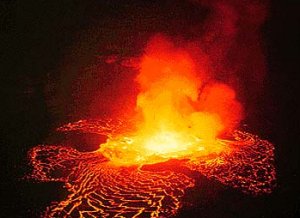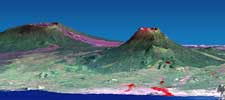|
Nyiragongo-volcano, a stratovolcano, closest neightbour to Nyamuragia,
situated at
01°.52'S og 29°25'E, reaching 3,469 m. asl. It is within the
Virunga-Nation Park's areal,
and is one of the most wellknown volcanoes in Africa. During the years
from 1894 to 1977,
a lavalake was dominating
the main crater. In the most recent years another lavalake has shown
phreatic explosions
with lavafountains.
Almost about 100 parasite-cones is to be found on the slopes of the
volcano, and they reach as
far as to the Kivu-lake. The Goma-observatory is situated 18 km South
of the main-crater.
Monday, November 22nd, 2004
| |
Lavasjøen i vulkanen, som reiser seg over
byen Goma, har steget betraktelig og sprer nå
frykt for at et ny ødeleggende utbrudd skal føre
til store ødeleggelser blant de mennesker
som var vitne til det foregående katastrofale utbruddet
i januar 2002. |
| |
The lava lake of the volcano, which
overlooks the Congolese city of Goma, has risen sharply,
prompting fears of a devastating eruption and causing unease among
those who survived the
last disaster, in January 2002.
Seismic recordings have detected tremors of increasing intensity
in the past week and visual
observation from the crater rim confirms a dramatic widening and
rising of the lava.
Mount Nyiragongo is undergoing a "feeding episode" which
appears to have started on
November 10, according to the Goma Volcano Observatory, an international
monitoring
group based in the city.
The present feeding in magma raises the question of a possible
injection within the fractures
opened in 2002 at the base of the volcano which could represent
a major risk for the
populated area
The scientists do not think an eruption is imminent and there
are no plans to evacuate Goma.
It is the sixth time since 1972 that Mount Nyiragongo has been
recorded feeding from its
15 mile-deep magma core, a phenomenon which results in important
rises in the lava lake
but do not systematically trigger eruptions, the observatory says.
.
However, a series of digital seismographs around the crater show
a slight widening in the
south flank of fractures which opened in 2002, and a 2C increase
in the temperature of the
fracture at the top of the volcano.
As they usual say: "It is certain the volcano will
erupt and engulf Goma, he says,
but the timing could be three weeks from now to several hundred
years." Because it is low
in silica Mount Nyiragongo cannot explode, but its lava can flow
extremely fast, and has
previously reached reached well over 50mph.
|
Thursday, July 29th, 2004
According to the Toulouse VAAC, an eruption began at Nyiragongo sometime
before
07:00 on 27 July. Satellite imagery showed that the plume produced from
the eruption rose
to between 3.6 and 4.9 km a.s.l.
May 3rd, 2003
As of the 2nd of May, the Goma Volcano Observatory (GVO) has reported
that an expedition
to Nyiragongo volcano by French Volcanologists on April 22-25 reported
5 active vents.
On 22nd April one vent was emitting ash asd spatter, the other 4 vents
were much more energetic,
showing a typical strombolian activity : violent gas outbursts with
almost permanent projections
of scoriae.This activity was permanent and lasted for approx. 8 hours.
Explosive activity increased
on 23rd April, and a lava pool was present in the crater. Splashes of
lava raised approx. 50-60 m
high and occasional waves of lava covered the crater floor and walls.
March 7th, 2003
The Goma Volcano Observatory (GVO) has reported that a volcanic ash
advisory issued from
Toulouse indicated that Meteosat imagary has detected an eruption from
Nyiragongo volcano.
An ash cloud extends 100 nautical miles W of the volcano. Winds were
no longer blowing ash
and Pele's hair to the S, therefore Goma and other cities S of the volcano
were no longer
affected by tephra fall. Pele's hair and/or ash fell SW of Nyiragongo
in the village of Rusayo,
affecting the water supply. Residents of villages around the volcano
reported seeing
incandescence atop Nyiragongo during the evening.
While visiting Nyiragongo's crater on 25 and 26 February, scientists
found that the interior
of the crater had changed since their last visit on 4 and5 February.
Vegetation had died in the
main crater and heavy ashfall had occurred on the S flank. During the
evening they saw intense
lava fountaining, with lava reaching probably more than 100 m high,
and a storm of Pele's hair.
Februar 19th, 2003
As of the 18th of February, the Goma Volcano Observatory (GVO) has
reported and confirmed
that Nyiragongo volcano is erupting. For the 4th consecutive day Pelee
hair is falling on the city
of Goma, indicating lava fountains are active in the crater. A volcanic
plume is visible 5 km
above the crater. Acid rainfall and Pelee hair is contaminating water
supplies in villages
surrounding the volcano. Crops have been damaged by the acid rain, and
livestock may
be affected by eating contaminated grass. Local witnesses report hearing
explosions from
the volcano.
(SWVRC)
26.juli 2002
|
|
New images from three NASA spacecraft chronicle the degree of
devastation caused by the January 17th eruption of the Nyiragongo
volcano in Congo.
FOLLOW
THIS LINK ! |
27.februar 2002
An U.N.volcanologist in Goma has resported a dramatic
increasing of the seismic activity has been detected on Monday 25th
of February. The renewed seismic activity was also widening some existing
fissures in the area, threatening additional lava and toxic gas flows.
One such fissure had been discovered beneath the Kanisa La Mungu church
in central Goma church. While the fissure was now emitting only weak
concentrations of carbon dioxide, two women cleaning the church recently
fainted and the site has now been sealed off.
(swvrc)

Foto:
Disaster Relief

Foto:
Disaster Relief
19.januar 2002

.
©BBC but
hope they don't mind...

©BBC but
hope they don't mind...

©AP but
hope they don't mind...
18.januar 2002 kveld

©Reuters but
hope they don't mind...
18.januar 2002 middag

Illustration. From refugee-camps in 1994.
Photograph by Jack Lockwood, U.S. Geological
Survey, August 22, 1994.
Relief
Web has an english report on the eruption, -
click here!
January 18th, 2002 morning

xx.xx.1994

Foto Jack Lockwood, U.S.G.S., 24.aug.1994
|
|
Linker:
|
|
|
Nyiragongo
- background by Tom Bacon |
|
|
Nyiragongo
Eruption 170102 – an overview. |
|
|
2002 Image Releases
from Jet Propulsion Laboratory |
|
|
Vulkanen Nyamuragira,
nabo til Nyiragongo - neighbour of Nyiragongo |
|
|
Virunga
National Park, with rare gorillas threatened by volcano |
|












